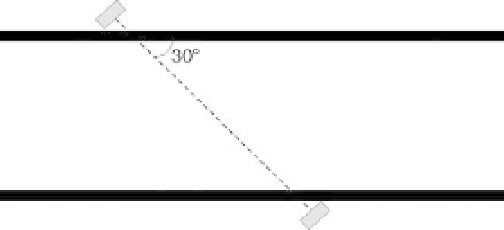Biomedical Engineering Reference
In-Depth Information
13.
Determine the ratio between the cross-sectional areas of two blood vessels assuming that the
voltage ratio induced in identical magnetic flow probes is equal to 2:3 and the ratio of blood
flows through these vessels is 1:5.
14.
A 4.5 k
linear rotary transducer is used to measure the angular displacement of the knee
joint. Calculate the change in output voltage for a 165
change in the angle of the knee.
Assume that a constant current of 14 mA is supplied to the transducer.
15.
Provide a step-by-step derivation of Eq. (10.11).
16.
An elastic resistive transducer with an initial resistance,
O
l
o
, is stretched to a
new length. Assuming that the cross-sectional area of the transducer changes during
stretching, derive a mathematical relationship for the change in resistance
R
o
, and length,
D
R
as a function of
the initial length,
l
o
; the change in length,
D
l
; the volume of the transducer,
V
; and the
resistivity, r.
17.
The area of each plate in a differential capacitor sensor is equal to 5.6 cm
2
. Calculate the
equilibrium capacitance in air for each capacitor assuming that the equilibrium displacement
for each capacitor is equal to 3 mm.
18.
Plot the capacitance (
y-
axis) versus displacement (
x
-axis) characteristics of a capacitance
transducer.
19.
Calculate the sensitivity of a capacitive transducer (i.e.,
D
C
/
D
d
) for small changes in
displacements.
20.
A capacitive transducer is used in a mattress to measure changes in breathing patterns of an
infant. During inspiration and expiration, the rate of change (i.e., dV/dt) in voltage across the
capacitor is equal to
1V/s, and this change can be modeled by a triangular waveform. Plot
the corresponding changes in current flow through this transducer.
21.
Derive the relationship for the current through the capacitor-equivalent piezoelectric crystal
as a function of V and C.
22.
Two identical ultrasonic transducers are positioned across a blood vessel, as shown in
Figure 10.44. Calculate the diameter of the blood vessel if it takes 380 ns for the ultrasonic
sound wave to propagate from one transducer to the other.
23.
Discuss the advantages of MEMS-type sensors.
FIGURE 10.44
Two identical ultrasonic transducers positioned across a blood vessel.


